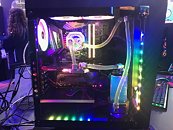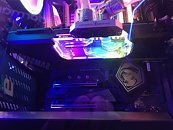- Joined
- Jul 1, 2014
- Messages
- 3,723 (0.94/day)
Why is it that each time something leaks from CORSAIR, it is from one of their resellers? This time, it was France-based LDLC who decided to show off an entire system filled with parts from CORSAIR's upcoming Hydro X business unit at Paris Games Week recently. This is our first look at CORSAIR's entry to custom watercooling, which was teased a couple of months ago, and looks like the inevitable launch will be sooner rather than later.
This entire venture started off with drama of its own, involving key personnel jumping ship from EK Waterblocks to CORSAIR about a year ago, and many were curious as to what this meant in terms of new options to the market. We will go through the photos one by one to identify and comment on all the parts, so be sure to click the full story as we dig deeper into the individual parts.


First up, the CPU water block. Designed in a similar manner to their new Hydro Platinum series of closed loop liquid coolers, we see what appears to be an acrylic top surrounded by an aluminium trim. The block form factor is larger than average, going by the other hardware used in the build, and there are addressable RGB LEDs integrated within for lighting support. The cooling engine itself is encompassed in a smaller circular region, with what appears to be a typical split central-inlet flow design as with just about any modern CPU block. Two G1/4" threaded ports greet us on the front, and the build system uses soft tubing with what may well be CORSAIR-branded nickel-plated brass compression fittings. It remains to be seen whether the tubing and coolant are also part of the company's offerings or outsourced at this point.

The GPU block is very interesting to see, with a design that is again distinctly CORSAIR while still being different enough from the rest of the market to carve out its own identity. Indeed, the I/O terminal at the top has the Hydro X series badge on it and looks like a CORSAIR Dominator Platinum RAM stick. On the side is the CORSAIR logo, lit up in more addressable RGB fashion, along with the block top which also appears to follow the CPU block design with an acrylic top and a metal cover. This style was adopted by Watercool, and then Phanteks, although it was popular among modders before. Once more we can see the cooling engine clearly here, although CORSAIR appears to have chosen a linear flow path this time with the coolant entering the block, going through microfins over the VRAM and GPU (this is clearly not an HBM implementation on the GeForce RTX PCB in question), on to the VRMs and then exiting the block. There appears to be a flow indicator by the VRM side, but it is unclear from the images at this point. The metal cover appears to be finned, although this is likely more for aesthetics than for function given this is a full cover block.


The reservoir and pump are integrated in a single piece in the build, and will likely be how they will be offered in the initial run. An integrated pump and reservoir work best for newcomers who do not have to worry about where to place the pump, the order of components in the loop, and accounting for additional space for the two if separate. As it stands, the reservoir appears to be acrylic again (the light diffraction through the reservoir would be different if it was glass), with a more rectangular cubiod shape than a cylinder (although this is more of a non-uniform octagon), and acetal tops for the reservoir and pump with more G1/4" threaded ports. More RGB to be seen here, including a small lit up logo on the top by the return and feed ports.


We do not yet know when these will be announced, and then released for purchase after that. CES is coming up, and it is a good place to debut the entire portfolio if CORSAIR decides to do so. The photos also do not reveal much about the radiator used, so that is another question mark currently. Given how they have focused on having iCUE be the unifying driver for their ecosystem this year, there is no doubt that all the lighting here will be controlled by iCUE to match the rest of the system if you have CORSAIR fans, LED strips, and peripherals. Similarly, we may see integrated temperature sensors in the blocks akin to their AIO coolers to allow for pump and fan control based on these measurements. Performance is an unknown, so let us know what you think about the design of these components as they currently are.
View at TechPowerUp Main Site
This entire venture started off with drama of its own, involving key personnel jumping ship from EK Waterblocks to CORSAIR about a year ago, and many were curious as to what this meant in terms of new options to the market. We will go through the photos one by one to identify and comment on all the parts, so be sure to click the full story as we dig deeper into the individual parts.


First up, the CPU water block. Designed in a similar manner to their new Hydro Platinum series of closed loop liquid coolers, we see what appears to be an acrylic top surrounded by an aluminium trim. The block form factor is larger than average, going by the other hardware used in the build, and there are addressable RGB LEDs integrated within for lighting support. The cooling engine itself is encompassed in a smaller circular region, with what appears to be a typical split central-inlet flow design as with just about any modern CPU block. Two G1/4" threaded ports greet us on the front, and the build system uses soft tubing with what may well be CORSAIR-branded nickel-plated brass compression fittings. It remains to be seen whether the tubing and coolant are also part of the company's offerings or outsourced at this point.

The GPU block is very interesting to see, with a design that is again distinctly CORSAIR while still being different enough from the rest of the market to carve out its own identity. Indeed, the I/O terminal at the top has the Hydro X series badge on it and looks like a CORSAIR Dominator Platinum RAM stick. On the side is the CORSAIR logo, lit up in more addressable RGB fashion, along with the block top which also appears to follow the CPU block design with an acrylic top and a metal cover. This style was adopted by Watercool, and then Phanteks, although it was popular among modders before. Once more we can see the cooling engine clearly here, although CORSAIR appears to have chosen a linear flow path this time with the coolant entering the block, going through microfins over the VRAM and GPU (this is clearly not an HBM implementation on the GeForce RTX PCB in question), on to the VRMs and then exiting the block. There appears to be a flow indicator by the VRM side, but it is unclear from the images at this point. The metal cover appears to be finned, although this is likely more for aesthetics than for function given this is a full cover block.


The reservoir and pump are integrated in a single piece in the build, and will likely be how they will be offered in the initial run. An integrated pump and reservoir work best for newcomers who do not have to worry about where to place the pump, the order of components in the loop, and accounting for additional space for the two if separate. As it stands, the reservoir appears to be acrylic again (the light diffraction through the reservoir would be different if it was glass), with a more rectangular cubiod shape than a cylinder (although this is more of a non-uniform octagon), and acetal tops for the reservoir and pump with more G1/4" threaded ports. More RGB to be seen here, including a small lit up logo on the top by the return and feed ports.


We do not yet know when these will be announced, and then released for purchase after that. CES is coming up, and it is a good place to debut the entire portfolio if CORSAIR decides to do so. The photos also do not reveal much about the radiator used, so that is another question mark currently. Given how they have focused on having iCUE be the unifying driver for their ecosystem this year, there is no doubt that all the lighting here will be controlled by iCUE to match the rest of the system if you have CORSAIR fans, LED strips, and peripherals. Similarly, we may see integrated temperature sensors in the blocks akin to their AIO coolers to allow for pump and fan control based on these measurements. Performance is an unknown, so let us know what you think about the design of these components as they currently are.
View at TechPowerUp Main Site




